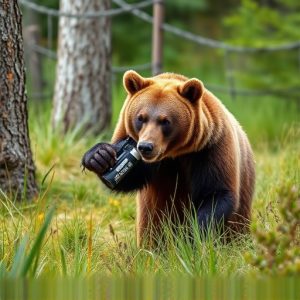Bear Repellent Spray: Effectiveness, Environmental Impact & Responsible Use
Bear spray, effective for deterring bears in outdoor settings, relies on capsaicin and odours to cre…….
Bear spray, effective for deterring bears in outdoor settings, relies on capsaicin and odours to create a protective barrier. Proper application is key to minimize soil contamination, with usage guidelines emphasizing moderation to avoid long-term ecological disruption. Environmental factors like UV light and humidity impact the duration of effectiveness, while responsible handling, storage, and disposal extend its usability while preserving wildlife habitats. Bear spray soil contamination duration should be managed to ensure a safe outdoor experience without ecological harm.
“Enhancing your camping experience and ensuring safety in bear country is now easier with the right tool—bear repellent spray. This comprehensive guide explores the essential aspect of bear spray, delving into its composition, effectiveness, and environmental impact. We dissect the duration of its protection against potential threats, offering insights on responsible use and disposal to minimize soil contamination risks. By understanding these factors, campers can make informed decisions, ensuring a memorable outdoor adventure.”
- Understanding Bear Spray: Its Composition and Efficacy
- The Impact of Bear Spray on Soil and the Environment
- Duration of Effectiveness: How Long Does Bear Spray Last?
- Responsible Use and Disposal: Minimizing Soil Contamination Risks
Understanding Bear Spray: Its Composition and Efficacy
Bear spray, also known as bear repellent, is a crucial component for any camping or outdoor adventure in regions inhabited by bears. Understanding its composition and efficacy is vital to ensure maximum protection during your outdoor escapades. This powerful tool is designed to deter aggressive bears when used correctly.
The primary active ingredient in bear spray is capsaicin, derived from chili peppers. This ingredient creates a burning sensation in the bear’s eyes, nose, and throat, temporarily blinding and disorienting it. Bear sprays are also often infused with other agents like piperidines and amine odours to enhance their effectiveness. The spray forms a protective barrier between you and the bear, ensuring a safe distance. While these repellents are highly effective in reducing bear attacks, proper usage is key. It’s important to follow instructions regarding soil contamination duration, as improper use can lead to environmental impact. Understanding the reach of the spray and practicing responsible usage will ensure your safety without causing harm to the ecosystem.
The Impact of Bear Spray on Soil and the Environment
Bear spray is a popular tool for campers and hikers to deter bears, but its environmental impact, particularly on soil, is an important consideration. When used properly, bear spray can effectively reduce bear-human conflicts without causing significant soil contamination. However, improper use or frequent application can lead to residual buildup of active ingredients in the soil, which may disrupt local ecosystems and wildlife habitats over time.
The duration of bear spray’s impact on soil varies based on factors such as the concentration of active ingredients, environmental conditions, and soil type. While some studies suggest that traces of bear spray can remain in the soil for several months, others indicate that natural degradation processes can reduce these levels rapidly under favorable conditions. It’s crucial to follow manufacturer guidelines and use only the recommended amount of bear spray during camping trips to minimize any potential environmental harm.
Duration of Effectiveness: How Long Does Bear Spray Last?
Bear spray’s effectiveness doesn’t just depend on its quality or the user’s application technique; it also varies based on environmental factors, including temperature and humidity. Typically, a single can of bear spray is designed to provide protection for about 20-30 seconds during a confrontation with a grizzly or black bear. Beyond this initial burst, the spray’s residue should remain effective for several hours, providing a lasting barrier against potential future encounters.
It’s important to note that bear spray soil contamination can impact its duration of effectiveness. If the spray comes into contact with the ground or other surfaces, it may degrade faster due to environmental conditions and UV light exposure. To maximize the spray’s longevity, users should follow application instructions carefully, keep cans in their original packaging, and store them properly in a cool, dry place.
Responsible Use and Disposal: Minimizing Soil Contamination Risks
When using bear repellent spray while camping, responsible handling and disposal are crucial to minimizing soil contamination risks. It’s essential to always read and follow manufacturer guidelines for proper use, ensuring the spray is aimed directly at potential threats with a safe distance maintained. After use, properly dispose of empty cans according to local regulations, avoiding littering or burying them in the wilderness.
To extend the duration of effectiveness and reduce environmental impact, store bear spray containers out of reach of wildlife and away from heat sources. Prevent accidental releases by keeping them secure during transportation. By adopting these responsible practices, campers can enjoy enhanced safety while minimizing the potential for soil contamination from bear spray residues.
Bear repellent spray is an essential tool for campers, but its responsible use and disposal are crucial to minimizing soil contamination risks. Understanding the composition and effectiveness of bear spray, along with its impact on the environment, ensures its optimal utilization. The duration of its effectiveness varies based on factors like temperature and application, so proper knowledge is key. By following best practices for use and disposal, campers can protect both wildlife and the natural ecosystem while enjoying their outdoor adventures, making it a game-changer in preventing bear spray soil contamination.


